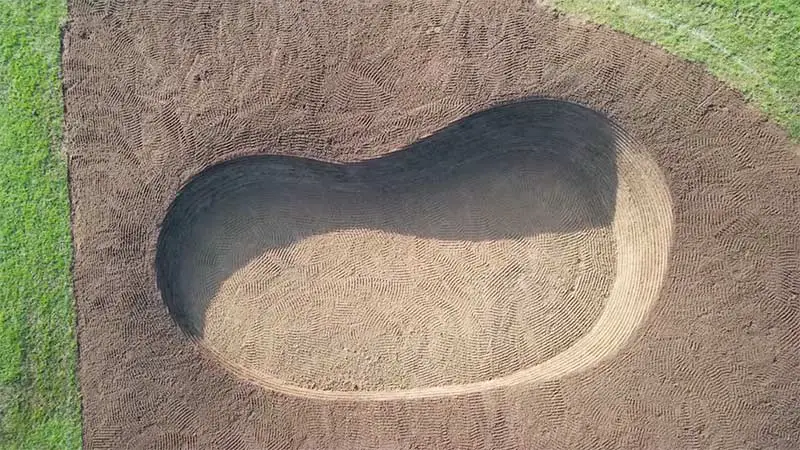Golf course architecture has long wrestled with the balance between aesthetic appeal and maintenance demands. Enter the revetted bunker, a solution that marries both needs seamlessly.
Originating in Scotland, these bunkers were designed to combat wind erosion by using layers of sod to create a sturdy, visually striking embankment.
Revetted bunkers, with their steep slopes and shadow-rich contours, offer a dramatic visual contrast that architects love. However, traditional sod requires significant upkeep, a challenge for superintendents aiming to reduce maintenance. The modern twist?
Artificial turf. This innovation maintains the classic look while drastically cutting down on the labor and resources needed to keep these bunkers in top shape.
In essence, revetted bunkers represent a blend of historical design and modern practicality, making them a compelling feature in contemporary golf course design.
What Are Revetted Bunkers?
Origins and Golf Course History
Revetted bunkers have roots in Scotland, where they were first used to combat wind erosion on golf courses. These structures date back to the 19th century, specifically in Fife Golf, known for its deep bunkers.
Initially, turf and soil were stacked to reinforce the bunker faces, an essential practice before modern alternatives existed.
This technique transitioned inland as golf spread, evolving from natural dunes and sand scrapes into intentionally designed hazards.
Early photos of the Old Course at St. Andrews illustrate the use of cut turf for bunker face reinforcement, now recognized as revetting.
Design and Construction Features
Revetted bunkers, constructed using layers of sod or synthetic materials, create a distinct layered effect. Traditional methods involve stacking grass and the underlying soil held together by roots.
Newer approaches use artificial turf to replicate the classic design while reducing maintenance. This method stabilizes steep slopes and enhances shadow contrast on course landscapes.
Engineers address challenges such as soil pressure and hydrostatic loads by utilizing durable materials like synthetic sod, ensuring long-term stability.
A typical installation involves a multi-person crew setting sod at 70-degree angles, supported by a sand-soil-peat mixture. Methodical stamping ensures each layer settles correctly, offering a robust and visually appealing design.
Advantages of Revetted Bunkers
Durability in Harsh Weather
Revetted bunkers provide enhanced durability, particularly under harsh weather conditions, by utilizing stacked layers of sod or synthetic materials that absorb and deflect environmental stress.
Traditional bunkers are prone to erosion and frequent maintenance, whereas revetted bunkers maintain structural integrity and reduce maintenance needs.
Stewart highlights that synthetic edging in revetted bunkers improves durability, demonstrated by its successful use at Brickyard Crossing.
Aesthetic Appeal and Tradition
Revetted bunkers add significant aesthetic appeal and reflect traditional golf course design, originating in Scotland and blending seamlessly with both links and parkland courses.
The stacked layers create striking visual contrasts and shadows, enhancing the landscape’s artistic value. These bunkers connect players with golf’s heritage by preserving historical design principles.
Architect Tim Liddy emphasizes maintaining this tradition while incorporating modern techniques to ensure revetted bunkers remain attractive in contemporary golf course architecture.
Challenges and Considerations
Maintenance and Upkeep Costs
Maintaining revetted bunkers involves costs that can impact a golf course’s budget. Artificial turf reduces the need for frequent repairs but comes with higher initial expenses.
Replacement cycles for synthetic materials extend for several years, but natural sod requires more regular attention. Labor costs are also significant since maintaining the crisp edges of revetted bunkers demands skilled groundskeepers.
Installation Process
The installation of revetted bunkers requires meticulous planning and precise execution. The process begins with excavating the bunker area to achieve the desired depth and shape. Once excavated, artificial or natural materials are stacked methodically.
Using synthetic materials involves cutting and fitting each piece to ensure stability and durability, while natural sod demands periodic irrigation and root establishment.
Despite higher upfront costs, using artificial turf often leads to long-term savings by reducing maintenance.
Revetted Bunkers in Modern Golf Courses
Notable Courses Featuring Revetted Bunkers
Prestigious golf courses now feature revetted bunkers to enhance playability and visual appeal. At the Old Course at St. Andrews, these bunkers create significant challenges, with most requiring strategic maneuvering.
Fife Golf also highlights the aesthetic and functional benefits of these historical designs. The use of artificial turf in revetted bunkers offers consistency and durability, addressing maintenance concerns and making them popular on prime courses worldwide.
The Future Trends in Bunker Design
Bunker design is evolving to balance aesthetics, playability, and maintenance, with artificial edges and synthetic materials reducing upkeep costs.
Steeper slopes with revetted designs add visual contrast and challenge. Advances in artificial turf technology promise more durable and visually striking bunkers.
These trends cater to both the need for less maintenance and the desire for bold designs, indicating that more courses will adopt these durable, low-maintenance bunkers without sacrificing intricate design elements.
Frequently Asked Questions
What is a revetted bunker?
A revetted bunker is a type of hazard on golf courses where layers of turf are stacked to form a steep face, providing durability against wind erosion and offering strategic challenges to golfers.
Why were revetted bunkers originally built?
Revetted bunkers were initially created in Scotland during the 19th century to combat wind erosion on golf courses, making them both functional and strategically significant hazards.
How have revetted bunkers evolved over time?
Originally made with stacked turf and soil, modern revetted bunkers now utilize artificial turf for increased longevity and reduced maintenance, providing cost savings in the long term.
What are some famous courses with revetted bunkers?
Notable courses with revetted bunkers include the Old Course at St. Andrews and Fife Golf. These courses are renowned for integrating these bunkers to enhance both aesthetics and playability.
Conclusion
Revetted bunkers remain a cornerstone of golf course design, blending tradition with modern innovation.
Their evolution from simple wind erosion solutions to sophisticated course features highlights the enduring appeal and strategic complexity they bring to the game.
By incorporating advanced materials like artificial turf, these bunkers offer a sustainable option that balances aesthetics and functionality.
As golf course architecture continues to advance, revetted bunkers will likely play a pivotal role in shaping the future of the sport, ensuring courses remain both visually stunning and challenging for players.








Colin McCarthy